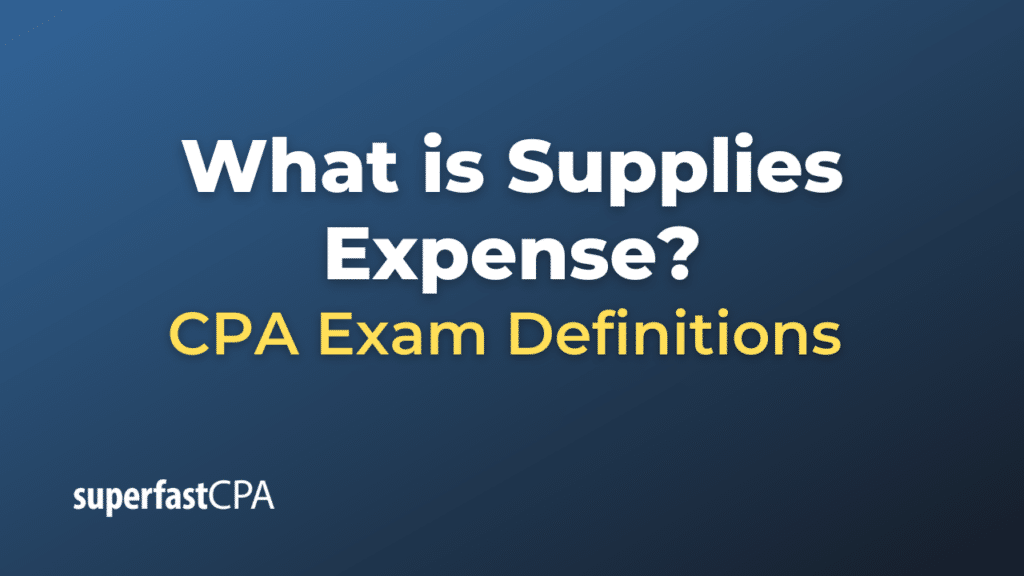Supplies Expense
“Supplies Expense” is an account in the general ledger used to capture the cost of supplies consumed during a specific accounting period. In the context of accounting, supplies can refer to items that are used and consumed within the normal course of business but aren’t directly tied to the product or service being sold. Instead, they support general business operations.
These are often items that get used up quickly or have a relatively short lifespan in the business environment. When these supplies are initially purchased, they might be recorded as an asset (like “Office Supplies”). As they are used up, their cost is transferred from the asset account to the “Supplies Expense” account to reflect their consumption.
Examples of items that might be considered under Supplies Expense include:
- Office Supplies: This can encompass items like pens, paper, staplers, notebooks, and other stationery items.
- Cleaning Supplies: Items such as brooms, cleaning agents, and mop heads.
- Breakroom Supplies: This might include coffee, snacks, disposable cups, or paper towels.
- Operating Supplies for Specific Industries: For instance, a medical clinic might have supplies like gloves, syringes, and cotton swabs.
The process usually involves two steps:
- When Supplies are Purchased: The amount is recorded as an asset. For example, if a company buys $500 worth of office supplies, it would debit “Office Supplies” (an asset account) for $500.
- As Supplies are Used: An estimate or actual count is done periodically (e.g., monthly, quarterly) to determine how much of the supplies have been used. The used amount is then recorded as an expense. If, at the end of the month, $300 worth of office supplies were used, the company would credit “Office Supplies” for $300 and debit “Supplies Expense” for the same amount.
The key principle here is the matching principle of accounting, which dictates that expenses should be recognized in the same accounting period as the revenues they help generate. By moving the cost of supplies from an asset to an expense as they’re used, businesses ensure that expenses are recognized appropriately.
Example of Supplies Expense
Let’s walk through a fictional example to illustrate the concept of “Supplies Expense” in action.
Scenario:
CityScape Designs,” an architectural firm, starts the month of July with $1,000 worth of office supplies in stock. Given the nature of their work, these supplies primarily include drafting paper, pencils, markers, and blueprint rolls.
On July 10th, they purchase an additional $500 worth of supplies, anticipating a busy month ahead with several big projects.
At the end of July, “CityScape Designs” takes an inventory of their supplies and determines that they have $700 worth of supplies remaining.
Accounting for Supplies:
- Beginning of July:
- “Office Supplies” (Asset account): $1,000 (This is the opening balance.)
- July 10th – Purchase of Supplies:
- Debit “Office Supplies” (Asset account) by $500
- Credit “Cash” or “Accounts Payable” by $500
- End of July – Adjusting for Supplies Used:
- Calculate the cost of supplies used:
Opening balance + Purchases – Ending balance
= $1,000 + $500 – $700 = $800 worth of supplies were used during July. - To account for the usage:
Debit “Supplies Expense” (Expense account) by $800
Credit “Office Supplies” (Asset account) by $800
- Calculate the cost of supplies used:
This means, for July, the Supplies Expense recognized on “CityScape Designs” income statement would be $800.
This example showcases the lifecycle of supplies in the accounting books from the time of purchase to their eventual usage. At the beginning of August, “CityScape Designs” would continue with an opening balance of $700 in their “Office Supplies” account, ready to adjust for new purchases and usage in the subsequent month.













